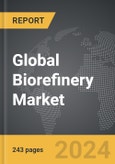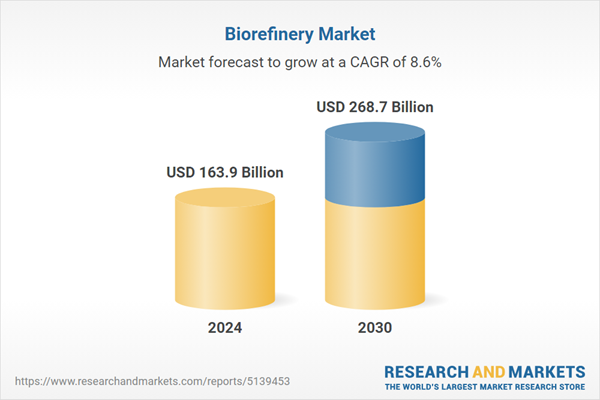The global market for Biorefinery was valued at US$163.9 Billion in 2024 and is projected to reach US$268.7 Billion by 2030, growing at a CAGR of 8.6% from 2024 to 2030. This comprehensive report provides an in-depth analysis of market trends, drivers, and forecasts, helping you make informed business decisions. The report includes the most recent global tariff developments and how they impact the Biorefinery market.
Segments: Technology (Industrial Biotechnology, Physico-Chemical Technology, Thermochemical Technology); Type (First Generation Biorefinery, Second Generation Biorefinery, Third Generation Biorefinery).
Geographic Regions/Countries: World; USA; Canada; Japan; China; Europe; France; Germany; Italy; UK; Rest of Europe; Asia-Pacific; Rest of World.
The analysts continuously track trade developments worldwide, drawing insights from leading global economists and over 200 industry and policy institutions, including think tanks, trade organizations, and national economic advisory bodies. This intelligence is integrated into forecasting models to provide timely, data-driven analysis of emerging risks and opportunities.
Global Biorefinery Market - Key Trends & Drivers Summarized
What Is a Biorefinery and Why Is It Important?
A biorefinery is an innovative facility that integrates biomass conversion processes and equipment to produce fuels, power, heat, and value-added chemicals from biomass. The concept is analogous to a petroleum refinery, which produces multiple fuels and products from crude oil; however, a biorefinery utilizes renewable biomass as its feedstock. The importance of biorefineries lies in their ability to provide a sustainable alternative to fossil fuels, reducing greenhouse gas emissions and dependence on non-renewable resources. By converting various types of biomass, such as agricultural residues, forestry waste, and energy crops, biorefineries can produce a wide array of products, including bioethanol, biodiesel, bioplastics, and biochemicals, which are essential for a circular economy.How Do Biorefineries Operate and What Technologies Are Involved?
Biorefineries operate by breaking down biomass into its constituent components through physical, chemical, and biological processes. Key technologies involved in biorefineries include thermochemical processes like pyrolysis and gasification, which convert biomass into bio-oil and syngas, respectively. These intermediates can then be upgraded into transportation fuels and chemicals. Additionally, biochemical processes such as fermentation and anaerobic digestion are used to produce bioethanol, biogas, and other valuable bioproducts. Advanced biorefineries often employ a combination of these technologies to maximize yield and efficiency. For instance, integrating enzymatic hydrolysis with fermentation can enhance the production of bioethanol from lignocellulosic biomass. The adoption of cutting-edge technologies like catalytic upgrading and microbial consortia further optimizes the biorefinery process, making it more competitive with traditional fossil-based refineries.What Are the Current Trends and Innovations in the Biorefinery Sector?
The biorefinery sector is witnessing several exciting trends and innovations aimed at improving efficiency, sustainability, and economic viability. One significant trend is the development of integrated biorefineries that combine multiple conversion processes to achieve higher product diversification and economic resilience. Innovations in feedstock flexibility are also notable, with advancements in pre-treatment technologies enabling the use of diverse biomass sources, including algae and municipal solid waste. Furthermore, the incorporation of green chemistry principles is driving the development of environmentally benign catalysts and solvents for biorefining processes. Another emerging trend is the production of high-value biochemicals and materials, such as bioplastics and biocomposites, which offer attractive economic returns. Research in genetic engineering and synthetic biology is also opening new avenues for enhancing microbial production strains, thereby increasing yields and reducing costs. These innovations are crucial for advancing the biorefinery sector and making it a cornerstone of the bioeconomy.What Drives the Growth in the Biorefinery Market?
The growth in the biorefinery market is driven by several factors, including technological advancements, regulatory support, and increasing demand for sustainable products. Innovations in biorefinery processes and feedstock utilization are enhancing the efficiency and cost-effectiveness of biorefineries, making them more competitive with conventional refineries. Regulatory frameworks and policies promoting renewable energy and sustainability are also crucial drivers, as they provide incentives and mandates for reducing carbon emissions and increasing the use of renewable resources. The rising consumer demand for eco-friendly products, such as bioplastics and bio-based chemicals, is further propelling market growth. Additionally, the diversification of end-use applications, including biofuels for transportation, biochemicals for industrial processes, and bioplastics for packaging, is expanding the market reach of biorefineries. Investments in research and development and strategic partnerships between industries and academic institutions are also contributing to the market's dynamic growth. These factors collectively ensure a robust expansion of the biorefinery market, aligning with global sustainability goals and the transition to a circular economy.Report Scope
The report analyzes the Biorefinery market, presented in terms of units. The analysis covers the key segments and geographic regions outlined below.Segments: Technology (Industrial Biotechnology, Physico-Chemical Technology, Thermochemical Technology); Type (First Generation Biorefinery, Second Generation Biorefinery, Third Generation Biorefinery).
Geographic Regions/Countries: World; USA; Canada; Japan; China; Europe; France; Germany; Italy; UK; Rest of Europe; Asia-Pacific; Rest of World.
Key Insights:
- Market Growth: Understand the significant growth trajectory of the First Generation Biorefinery segment, which is expected to reach US$143.1 Billion by 2030 with a CAGR of a 8.4%. The Second Generation Biorefinery segment is also set to grow at 8.7% CAGR over the analysis period.
- Regional Analysis: Gain insights into the U.S. market, valued at $55.9 Billion in 2024, and China, forecasted to grow at an impressive 8.8% CAGR to reach $31.9 Billion by 2030. Discover growth trends in other key regions, including Japan, Canada, Germany, and the Asia-Pacific.
Why You Should Buy This Report:
- Detailed Market Analysis: Access a thorough analysis of the Global Biorefinery Market, covering all major geographic regions and market segments.
- Competitive Insights: Get an overview of the competitive landscape, including the market presence of major players across different geographies.
- Future Trends and Drivers: Understand the key trends and drivers shaping the future of the Global Biorefinery Market.
- Actionable Insights: Benefit from actionable insights that can help you identify new revenue opportunities and make strategic business decisions.
Key Questions Answered:
- How is the Global Biorefinery Market expected to evolve by 2030?
- What are the main drivers and restraints affecting the market?
- Which market segments will grow the most over the forecast period?
- How will market shares for different regions and segments change by 2030?
- Who are the leading players in the market, and what are their prospects?
Report Features:
- Comprehensive Market Data: Independent analysis of annual sales and market forecasts in US$ Million from 2024 to 2030.
- In-Depth Regional Analysis: Detailed insights into key markets, including the U.S., China, Japan, Canada, Europe, Asia-Pacific, Latin America, Middle East, and Africa.
- Company Profiles: Coverage of players such as Archer-Daniels-Midland Company, Chevron Renewable Energy Group, Dominion Energy, Inc., Green Plains Inc., Honeywell UOP and more.
- Complimentary Updates: Receive free report updates for one year to keep you informed of the latest market developments.
Some of the 48 companies featured in this Biorefinery market report include:
- Archer-Daniels-Midland Company
- Chevron Renewable Energy Group
- Dominion Energy, Inc.
- Green Plains Inc.
- Honeywell UOP
- Neste Oyj
- Permolex Ltd.
- POET, LLC
- UPM Group
- Valero Energy Corporation
Tariff Impact Analysis: Key Insights for 2025
Global tariff negotiations across 180+ countries are reshaping supply chains, costs, and competitiveness. This report reflects the latest developments as of April 2025 and incorporates forward-looking insights into the market outlook.The analysts continuously track trade developments worldwide, drawing insights from leading global economists and over 200 industry and policy institutions, including think tanks, trade organizations, and national economic advisory bodies. This intelligence is integrated into forecasting models to provide timely, data-driven analysis of emerging risks and opportunities.
What’s Included in This Edition:
- Tariff-adjusted market forecasts by region and segment
- Analysis of cost and supply chain implications by sourcing and trade exposure
- Strategic insights into geographic shifts
Buyers receive a free July 2025 update with:
- Finalized tariff impacts and new trade agreement effects
- Updated projections reflecting global sourcing and cost shifts
- Expanded country-specific coverage across the industry
Table of Contents
I. METHODOLOGYMII. EXECUTIVE SUMMARY2. FOCUS ON SELECT PLAYERSIII. MARKET ANALYSISIV. COMPETITION
1. MARKET OVERVIEW
3. MARKET TRENDS & DRIVERS
4. GLOBAL MARKET PERSPECTIVE
UNITED STATES
CANADA
JAPAN
CHINA
EUROPE
FRANCE
GERMANY
ITALY
UNITED KINGDOM
REST OF EUROPE
ASIA-PACIFIC
REST OF WORLD
Companies Mentioned (Partial List)
A selection of companies mentioned in this report includes, but is not limited to:
- Archer-Daniels-Midland Company
- Chevron Renewable Energy Group
- Dominion Energy, Inc.
- Green Plains Inc.
- Honeywell UOP
- Neste Oyj
- Permolex Ltd.
- POET, LLC
- UPM Group
- Valero Energy Corporation
Table Information
| Report Attribute | Details |
|---|---|
| No. of Pages | 291 |
| Published | April 2025 |
| Forecast Period | 2024 - 2030 |
| Estimated Market Value ( USD | $ 163.9 Billion |
| Forecasted Market Value ( USD | $ 268.7 Billion |
| Compound Annual Growth Rate | 8.6% |
| Regions Covered | Global |









